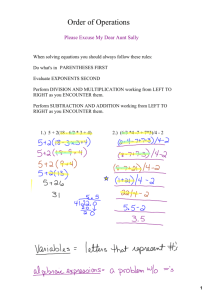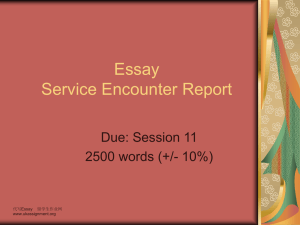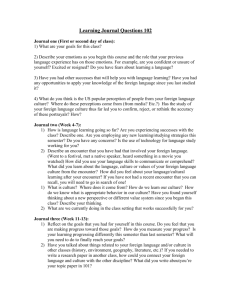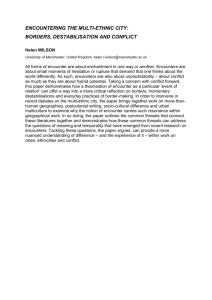Service Encounter
advertisement
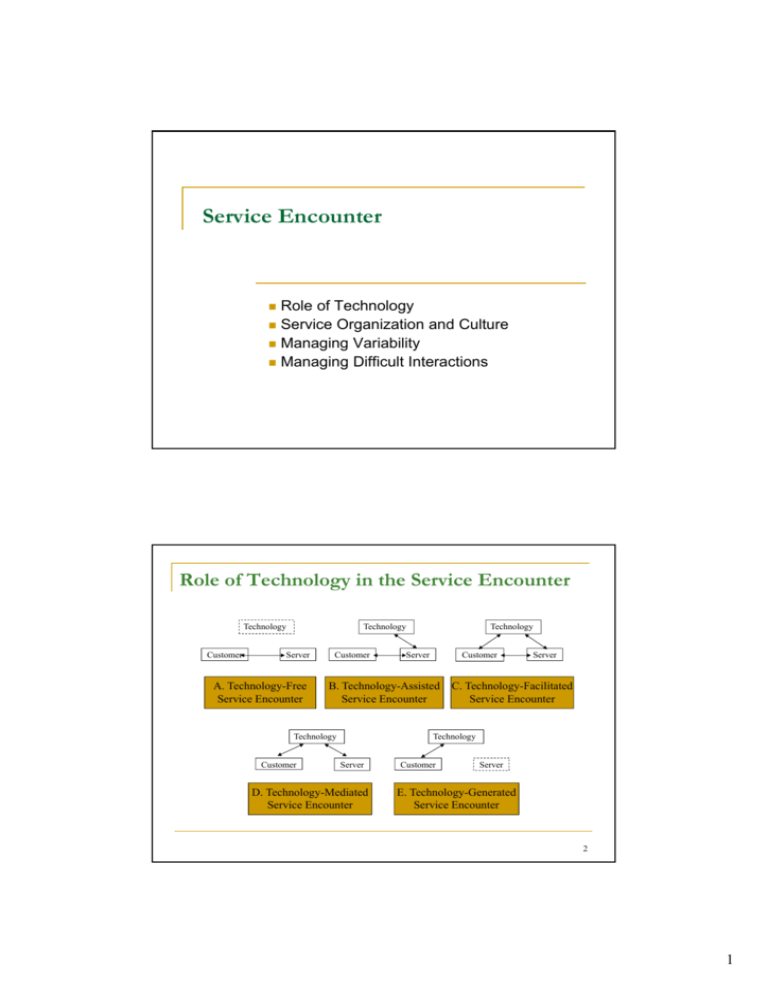
Service Encounter Role of Technology Service Organization and Culture Managing Variability Managing Difficult Interactions Role of Technology in the Service Encounter Technology Customer Technology Server A. Technology-Free Service Encounter Customer Server Customer B. Technology-Assisted Service Encounter Technology Customer Technology Server C. Technology-Facilitated Service Encounter Technology Server D. Technology-Mediated Service Encounter Customer Server E. Technology-Generated Service Encounter 2 1 Evolution of Service Encounter Service Industry Human Contact Machine Assisted ATM Internet Facilitated Banking Teller Online banking Grocery Checkout clerk Self-checkout station Online order/ pickup Airlines Ticket agent Check-in kiosk Print boarding pass Restaurants Wait person Vending machine Online order/ delivery Movie theater Ticket sale Kiosk ticketing Pay-for-view Book store Information clerk Stock-availability terminal Online shopping Education Teacher Computer tutorial Distance learning Gambling Poker dealer Computer poker Online poker 3 The Service Encounter Triad Service Organization Efficiency versus autonomy Contact Personnel Efficiency versus satisfaction Perceived control Customers 4 2 Service Organization The service encounter occurs within the context of an organization’s culture as well as its physical surroundings. Employee Selection Training Control + Empowerment Strategy + Culture 5 Ritz-Carlton Hotel- The Seven Day Countdown • Day One: Staff Orientation – Warm welcome, Philosophy, Gold Standards,… • Day Two: Departmental Vision Sessions – Group work, understand working purpose,… • Day Three through Seven: Skills Training – Daily line‐up, uniform fittings, handling guest difficulties, technical training,… Presented by DIJANA RISTIC & JULA FREIDL 3 Contact Personnel Selection 1. Abstract Questioning 2. Situational Vignette 3. Role Playing Training Unrealistic customer expectations Unexpected service failure 7 Example: Amy’s Ice Cream What was your most rewarding past experience and why? What are you looking for in your next job? What have you done in the past to irritate a customer? What flavor of ice cream best describes your personality? 8 4 Empowerment and Training Train and trust the inherent power within employees to evaluate choices and competently execute creative decisions. 1. Invest in people as much as in machines. 2. Use technology to support contact personnel rather than to monitor or replace them. 3. Consider the recruitment and training of contact personnel as critical to the firm’s success. 4. Link compensation to performance for employees at all levels. 9 Managing Customer-Introduced Variability A trade-off between cost and service quality (customer satisfaction) 10 5 Managing Customer-Introduced Variability 11 Difficult Interactions with Customers Unrealistic customer expectations 1. Unreasonable demands 2. Demands against policies 3. Unacceptable treatment of employees 4. Drunkenness 5. Breaking of societal norms 6. Special-needs customers Unexpected service failure 1. Unavailable service 2. Slow performance 3. Unacceptable service 12 6 Recovery of Service Failures Server Errors Customer Errors Task: Doing work incorrectly Treatment: Failure to listen to customer Tangible: Failure to wear clean uniform Preparation: Failure to bring necessary materials Encounter: Failure to follow system flow Resolution: Failure to signal service failure 13 Examples of Unethical Behaviors Misrepresenting the Nature of the Service • Promising a nonsmoking room when none is available • Using bait-and-switch tactics • Creating a false need for service • Misrepresenting the credentials of the service provider • Exaggerating the benefits of a specific service offering Customer Manipulation General Honesty and Integrity • Giving away a guaranteed reservation • Performing unnecessary services • Padding a bill with hidden charges • Hiding damage to customer possessions • Making it difficult to invoke a service guarantee • Treating customers unfairly or rudely • Being unresponsive to customer requests • Failing to follow stated company policies • Stealing customer credit card information • Sharing customer information with third parties 14 7 The Customer is Not Always Right Southwest managers tell employees they are Southwest's No. 1 customer, that the paying customer is not always right. Thinking the paying customer is right all the time, Southwest executives say, only undermines the trust between management and employees. "The theory goes that if we treat our employees well, they'll treat the customer well," a Southwest executive said. And that translates, most of the time anyway, into profits. Washington Post April 08, 2003 15 Service Encounter Success Factors Service Provider Human Customer Human Machine Machine Employee selection Interpersonal skills Support technology Engender trust Intuitive interface Verification Security Easy to access Easy to access Fast response Verification Remote monitoring Compatibility Tracking Verification Security Failsafe 16 8 Summary Service encounter is viewed as a triad. Select and empower the contact personnel. Training to anticipate possible situations. The Customer is Not Always Right. New area: machines serving human customers 17 9
